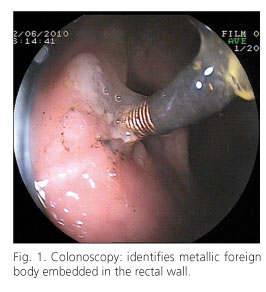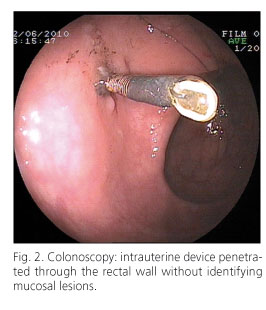My SciELO
Services on Demand
Journal
Article
Indicators
-
 Cited by SciELO
Cited by SciELO -
 Access statistics
Access statistics
Related links
-
 Cited by Google
Cited by Google -
 Similars in
SciELO
Similars in
SciELO -
 Similars in Google
Similars in Google
Share
Revista Española de Enfermedades Digestivas
Print version ISSN 1130-0108
Rev. esp. enferm. dig. vol.104 n.8 Madrid Aug. 2012
https://dx.doi.org/10.4321/S1130-01082012000800007
PICTURES IN DIGESTIVE PATHOLOGY
Endoscopic removal of intrauterine device penetrated through the rectal wall
Extracción endoscópica de dispositivo intrauterino penetrado en recto
María Antonia Huertas-Velasco and Mariano Gómez-Rubio
Hospital Universitario de Getafe. Madrid, Spain
Introduction
Following sterilization, intrauterine devices (IUDs) are the most widely used contraceptives in the world, especially in developing countries (1). Nowadays, IUDs are made of plastic, metal (mainly copper) and a small string. Uterine perforation is found in 1/350-1/2.500 inserts. It leads to the migration of the IUD, usually to adjacent organs to the uterus such as the rectum. Also there are reports of devices in the peritoneum, omentum, appendix and colon (2,3). We report a case of partial migration of an IUD into the lumen of the rectum, which was diagnosed and successfully removed by colonoscopy.
Case report
A 33-year-old-woman consulted for vaginal bleeding. She had a previous history of two pregnancies with eutocic births and insertion of a copper IUD (Nova T380) 4 months before. Pregnancy test resulted positive. On examination, the IUD strings were not displayed, neither were they on transvaginal ultrasound. A voluntary abortion was performed. Three months later, the patient came to our hospital with the sensation of IUD expulsion. On rectal examination, a foreign body with filamentary material was appreciated. By colonoscopy, a metal body with strings embedded in the wall was identified (Figs. 1-3). This body was completely removed by gentle traction with forceps, remaining a minimum hole without further complications (Figs. 4,5).
Discussion
The migration of the IUDs is a serious complication. It is suspected when they have not been expelled and are not found in their location. Usually, they can be shown by a radiograph or a transvaginal ultrasound (4). Rectal perforation by IUD, usually asymptomatic, is a rare complication, with a few cases reported in the literature. After its identification, the complete endoscopic retrieval of the device is achievable (5). The type of material favors a low foreign body reaction. In addition, the rectal anatomy, mainly extraperitoneal, determines that endoscopic removal is usually safe, without significant injury to the surrounding tissues except minimal residual fistulous tracts, which repaired spontaneously. Only in a few cases, the use of endoscopic hemoclips has been described (6).
References
1. Institut national d'études démographiques (INED) (2006). Available at: www.ined.fr/en/everything_about_population/faq/naissances_natalite/bdd/q_text/what_are_the_most_widely_used_contraceptive_methods_across_the_world_/question/80/ [ Links ]
2. Vandaele N, Iwanicki-Caron I, Piat M, Hervé S, Ducrotté P. Translocation of an intra-uterine contraceptive device with sigmoid penetration through an endometriosic nodule. Gastroenterol Clin Biol 2009;33:488-90. [ Links ]
3. Sentilhes L, Lefebvre-Lacoeuille C, Poilblanc M, Descamps P. Incidental finding of an intrauterine device in the sigmoid colon. Eur J Contracept Reprod Health Care 2008;13:212-4. [ Links ]
4. Rola S. AM, Jaber AA, Maher M A, Basel MAS. Migration of an intrauterine contraceptive device into the sigmoid colon. Saudi Med J 2009;30:561-3. [ Links ]
5. Ebel L, Foneron A, Troncoso L, Cañoles R, Hornig A, Corti D. Migración de dispositivo intrauterino a vejiga: Aportación de cuatro casos. Actas Urol Esp 2008;32:530-2. [ Links ]
6. Assarian A, Raja MA. Colonoscopic retrieval of a lost intrauterine contraceptive device: A case report and review of articles. Eur J Contracept Reprod Health Care 2005;10:261-5. [ Links ]











 text in
text in 







